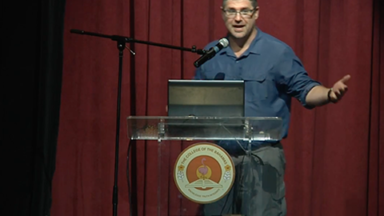Deep-water carbonate mound and associated hardground habitats along the western margin of Little Bahama Bank: keys to the past and a baseline for the future
Presented by Charles G. Messing
Charles G. Messing, Sönke Johnson, Steven H. D. Haddock, Edith A, Widder, A. Conrad Neumann, and Tamara M. Frank
A broad swath of carbonate mounds lies along the western margin of Little Bahama Bank at depths of 300-700 m. Submersible observations reveal that these mounds support often dense and highly diverse assemblages of attached, suspension-feeding invertebrates dominated by octocorals, sponges, crinoids, arborescent zoanthids, and stylasterid and scleractinian corals. Many occur no further north. Biozonation on hard substrates appears chiefly dependent on depth (and associated parameters, e.g., temperature) and current flow. Elongated lithoherms in 500-700 m with up to 50 m vertical relief support three faunal zones: ahermatypic branching scleractinians upcurrent, arborescent zoanthids on and near the crest, and stalked crinoids and octocorals on flanks and downcurrent end. Surrounding hardgrounds support many flank taxa accompanied by additional taxa absent from mounds. Mounds in 300-400 m with up to 30 m relief support dense assemblages on gentler upcurrent slopes and flanks, including stalked crinoids on upcurrent slope and crest, octocorals on flanks, and branching ahermatypic corals and basketstars at and near the crest. Steep downcurrent slopes are chiefly barren. In 500-600 m on the southwestern bank margin, mounds distinct from lithoherms and with up to 40 m vertical relief support a dense assemblage dominated by lithistid sponges and ophiacanthid ophiuroids; limited local biozonation here may be associated with a weaker flow regime. Fishes associated with mounds include potential fishery species such as wreckfish (Polyprion americanum), misty grouper (Hyporthodus mystacinus), alfonsino (Beryx decadactylus), sixgill shark (Hexanchus griseus), and Cuban dogfish (Squalus cubensis), although it is unknown if any occur in commercially viable numbers. Several long-lived taxa reflect the great stability of at least some of these habitats and can serve as proxy records of historical biogeochemical and oceanographic/climate changes, e.g., zoanthid Kulamanamana sp. (formerly Gerardia sp.) colonies may reach 1,800±300 y old. However, faunal diversity remains poorly known–new species continue to be discovered–and almost nothing is known of population dynamics, trophic dynamics, or life cycles. Therefore, the combination of apparent long-term habitat stability and severely limited data on ecology and physiology of the inhabitants makes further study of these environments a priority.







Recent Comments